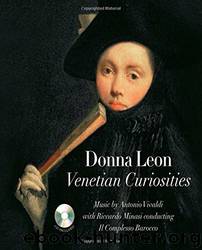Venetian Curiosities by Donna Leon

Author:Donna Leon [Leon, Donna]
Language: eng
Format: epub
Tags: Literary Collections, Essays
ISBN: 9781448136056
Google: XMPQV1qZJogC
Amazon: 0802120318
Publisher: Random House
Published: 2012-04-02T23:00:00+00:00
The Truth Is What You Choose It to Be
ANY FOREIGNER WHO lives in Italy long enough (ten minutes will suffice) will come upon the word dietrologia. Roughly translated, this refers to the science of discovering what stands behind things or, in simpler terms, the science of finding out what really caused things to happen. Just as Italians cannot abandon their belief that the common cold is transmitted only by un corrente d’aria, they are similarly incapable of believing any official explanation of events, preferring to seek more arcane or sinister causes. Even the most cursory reading of their history, ancient or recent, suggests that this might indeed be the path to wisdom.
An example of cloudy motivation is to be found in the story of Antonio Foscarini, son of one of Venice’s most illustrious families. His career began splendidly: he was Venetian ambassador to both the courts of King Henry IV of France and James I of England. In 1615, however, Foscarini was called back to Venice, accused of treason with Spain by his secretary, and imprisoned for three years while the charge was examined. In 1618, he was fully exonerated, released from prison, and restored to his seat in the Senate with full honors. The secretary was sentenced to only two years in prison for calumny.
In 1622, Foscarini was again accused of treason with Venice’s then-enemy Spain, this time by two agents of the Inquisition. He was arrested, imprisoned, condemned, strangled (he was a nobleman so there could be no public execution in front of the lower classes), and hung from one foot between the columns of San Marco and San Teodoro.
Less than a year later, the Council of Ten, which ruled La Serenissima, published a full exoneration of Foscarini, admitting that the unanimous condemnation had been mistaken. His denouncers were tried and convicted of false accusation, but before they could give any explanation of their crime, or tell who might have been behind it, they were hanged. Since then, historians have contrasted the conservative politics of the council that condemned Foscarini with the more liberal politics of the one that voted to exonerate him and have explained the two actions as responses to various religious and political forces then current in Europe.
Common belief, however, as is often the case, has found a more simple explanation, at least for Foscarini’s failure to defend himself: love, or at least lust. The palazzo that he had been seen entering, supposedly to pass state secrets to his Spanish handlers, was also the home of the Countess of Arundel, wife of Thomas Howard, 2nd Earl of Arundel, a man whose high position at the English court would have made their meeting with Foscarini during his time in London inevitable.
In the accusation that led to his death, Foscarini was said to have entered the house of foreign enemies “in disguise and in normal dress,” and to have been in their company “by day and by night.” In a city famous for the disguises common to
Download
This site does not store any files on its server. We only index and link to content provided by other sites. Please contact the content providers to delete copyright contents if any and email us, we'll remove relevant links or contents immediately.
| Diaries & Journals | Essays |
| Letters | Speeches |
The Rules Do Not Apply by Ariel Levy(4910)
Bluets by Maggie Nelson(4510)
Too Much and Not the Mood by Durga Chew-Bose(4302)
Pre-Suasion: A Revolutionary Way to Influence and Persuade by Robert Cialdini(4182)
The Motorcycle Diaries by Ernesto Che Guevara(4050)
Walking by Henry David Thoreau(3922)
Schaum's Quick Guide to Writing Great Short Stories by Margaret Lucke(3343)
What If This Were Enough? by Heather Havrilesky(3286)
The Daily Stoic by Holiday Ryan & Hanselman Stephen(3264)
The Day I Stopped Drinking Milk by Sudha Murty(3174)
The Social Psychology of Inequality by Unknown(2987)
Why I Write by George Orwell(2911)
Letters From a Stoic by Seneca(2749)
A Short History of Nearly Everything by Bryson Bill(2659)
A Burst of Light by Audre Lorde(2568)
Insomniac City by Bill Hayes(2519)
Feel Free by Zadie Smith(2456)
Upstream by Mary Oliver(2368)
Miami by Joan Didion(2343)
